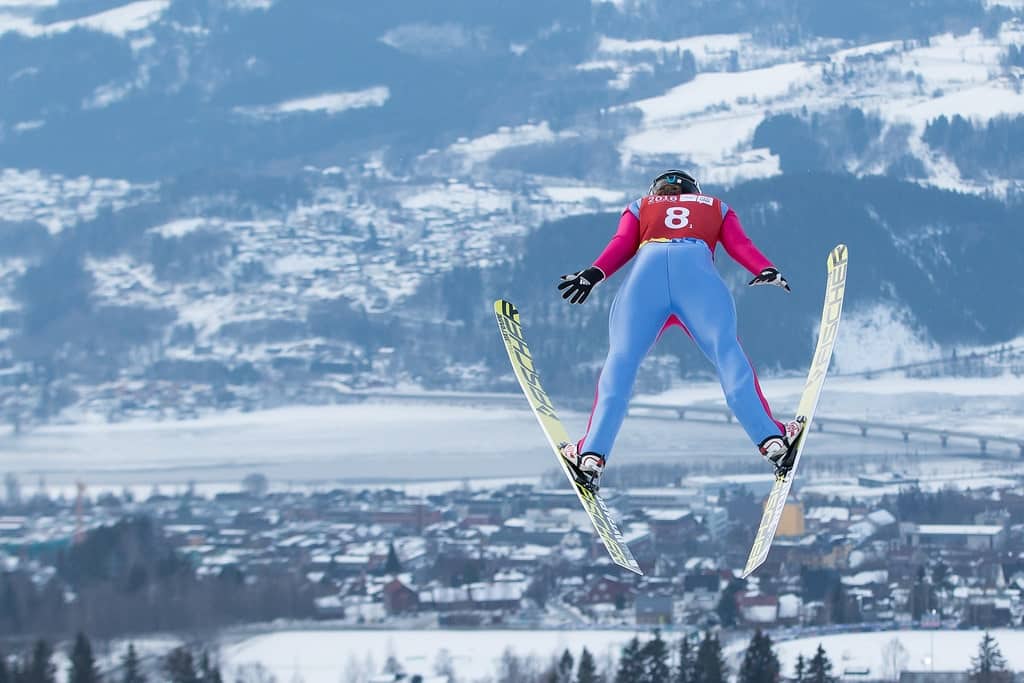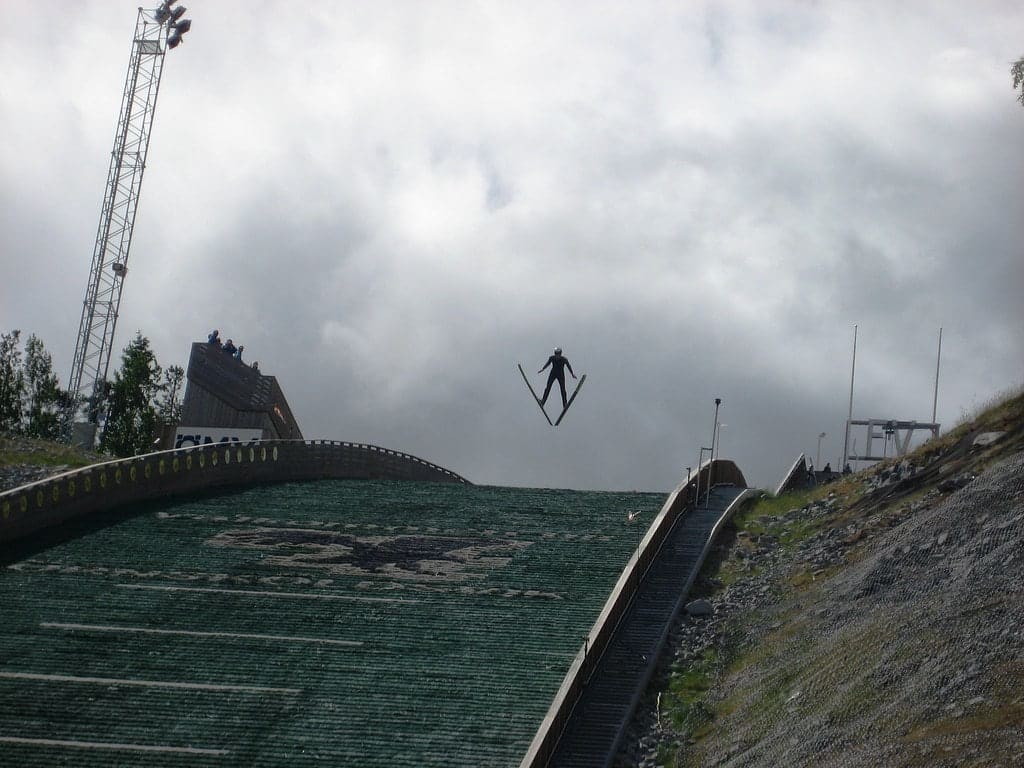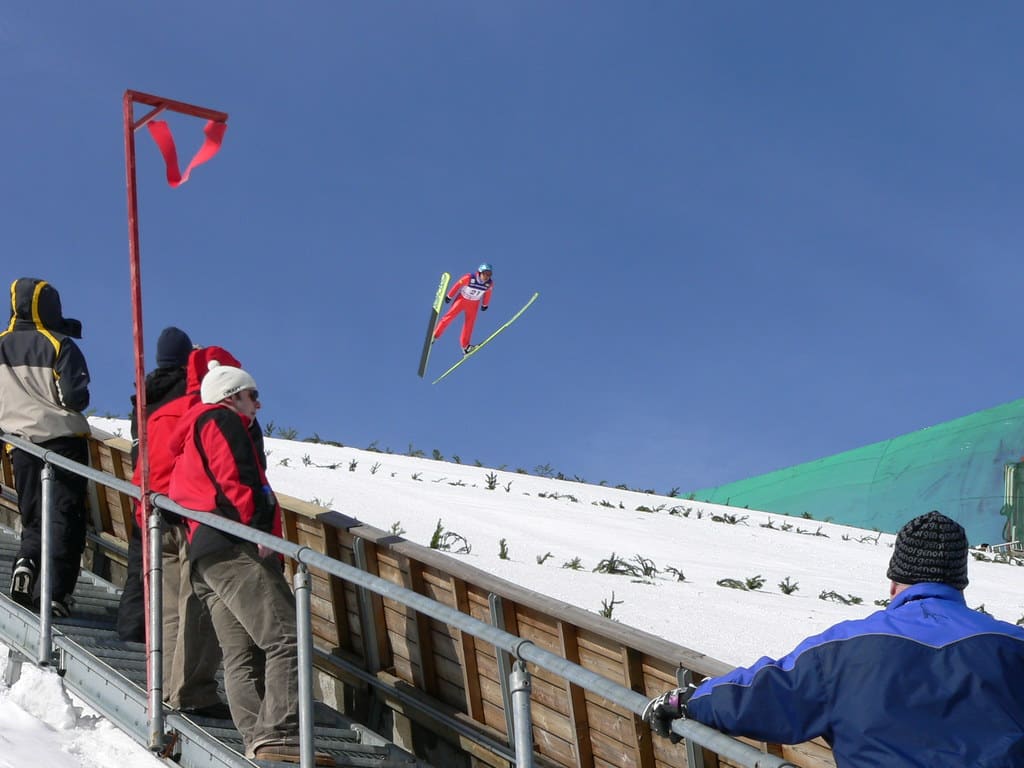How is Ski Jumping Scored? (Not Distance!)
By its nature ski jumping is a spectacular sport where the ski jumper treads a very fine line between a crowd-pleasing, successful jump, or a complete disaster in front of everyone. . But when ski jumpers take to the ramp how is ski jumping scored?
Ski jumpers are scored on several factors, principally their ability to land on or close to their par distance or K-point. Points are awarded for good style and control during flight, as well as a clean and controlled landing. On competition days headwinds or tailwinds are compensated for by using higher or lower start gates to ensure adequate take-off speed.

We are reader supported. We may collect a share of sales from the links on this page. As an Amazon Associate, we earn from qualifying purchases.
The discipline consequently attracts a steady stream of eccentrics among the hard-core athletes. Celebrity Eddie the Eagle soared through the air at the Calgary Olympics in 1988 and Norwegian, Robert Johannson, earned himself a reputation as the man with the ‘flying mustache’ a few years later
Ski jumping always pulls an enthusiastic crowd, who like the spectacular nature of the sport.
Ski jumping has a surprisingly long history, back in Norway in 1808. Ole Rye, a Norwegian major general in the army, felt the need to demonstrate to his men not only his skiing prowess but his bravery too.
Luck would have it that there was a small hill where they were stationed, where Rye took up a position at the top of the hill and launched himself down the slope, trailblazing into the record books with a length of 30 feet (9.5 m). Small beer compared with today’s athletes, but ski jumping was born.
The sport progressed slowly over the years until it was finally accepted as a new discipline in the Winter Olympics of 1924 in Chamonix, France, where Jacob Tullin Thams won gold in another first for Norway.
Improved Technology and Athleticism Transformed the Sport

As technology and athleticism improved over the years the sport was upgraded with a second larger slope, where ski jumpers could attract more spectators by achieving much better height and distance.
Modern-day ski jumping ramps are permanent, man-made constructions. The ramp or in-run is designed with two ceramic channels into which the ski jumper’s skis slot. An integral cooling system ensures the water in the two ceramic channels remains frozen, which ensures minimum friction and faster launches for the ski jumper.
Each Jump has Four Stages
There are four stages to each ski jump.
- Firstly, the in-run, where the ski jumper crouches to gain speed as he accelerates down the ramp.
- The second stage is the jump, where the ski jumper launches off the end of the ramp. To achieve a good jump, it is critical the ski jumper launches at exactly the right second to optimize maximum speed and momentum in the leap.
- In the third stage, the ski jumper continues through the flight, maneuvering his skis into a V-configuration to maximize lift and maintain control.
- Finally, the fourth stage involves the landing, where the ski jumper is aiming for a controlled and accurate touchdown.
Scoring in Ski Jumping

As part of the rules, ski jumpers are given a nominal par to aim for when landing. This variable point goes by several different names, the K-point, the calculation point, and the construction point. The ski jumper aims to land as close to their nominated K-point as possible, knowing they will have points deducted for landings on either side of it.
Two main sizes of the hill are used in ski jumping, which has associated K-point distances:
| Size of the Hill | Hill size | K-point |
| Normal Hill | 85-109 m | 75-99 m |
| Large Hill | 110-184 m | 100-169 m |
As with any sport involving flight, the local weather conditions may have a bearing on which gate on the in-run is used on a particular day. In windy conditions, for example, a headwind might call for the ski jumper to start from a higher gate to ensure he can gain adequate speed at take-off. Likewise, a tailwind advantage will warrant a lower gate.
The advantage of a higher gate is penalized in the overall scoring and vice versa for launching from a lower gate. Ski jumpers often leave the in-run with an all-important, explosive leap, when they are often traveling more than 60 mph.
During take-off, the ski jumper aims to achieve maximum lift and distance, while at the same time concentrating on their target K point in the distance, which is marked across the landing area. During the flight keeping a clear perspective on the landing area can be difficult with only snow to reference. Consequently, plants or markers are used along the length of the run to create clearer points of reference, which are particularly useful during mist or falling snow.
Originally, on launching from the ramp ski jumpers would lean forward and keep their skis parallel. At the time this was seen as the most efficient way to gain height and distance. However, during the 1980s, as wider skis became more prevalent, ski jumpers adopted a V-shape with their skis, which offers superior aerodynamics and control.
What Other Factors Come Into Ski Jump Scoring?

In each ski jump competition, ski jumpers make two jump attempts. As well as landing close to their K-point ski jumpers are also marked on style. Points are awarded or deducted for a clean, well-controlled flight and a clean landing with parallel skis. Touching the ground on landing with the hands is marked as a penalty.
Similarly, the effects of wind on the day may result in alternate gates being used to compensate. Even changing wind conditions during a competition may warrant the use of different start gates, to even out the challenge each ski jumper is subjected to.
As with other fast-paced sports, technology began to exert ever more control. Now the fabric that ski jumpsuits are manufactured from is regulated to limit the advantage to individuals. Similarly, bodyweight also figures in the jump scoring calculation. Lighter ski jumpers can usually jump longer distances and are consequently penalized by using shorter skis, which offer less lift and shorter distances.






